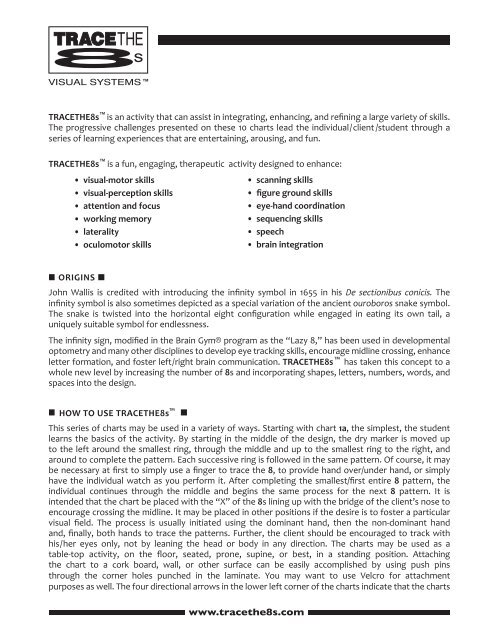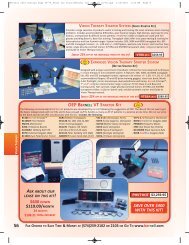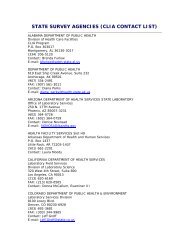Download this PDF to learn about Trace the 8's. - Bernell
Download this PDF to learn about Trace the 8's. - Bernell
Download this PDF to learn about Trace the 8's. - Bernell
You also want an ePaper? Increase the reach of your titles
YUMPU automatically turns print PDFs into web optimized ePapers that Google loves.
TRACETHE8s is an activity that can assist in integrating, enhancing, and refi ning a large variety of skills.<br />
The progressive challenges presented on <strong>the</strong>se 10 charts lead <strong>the</strong> individual/client /student through a<br />
series of <strong>learn</strong>ing experiences that are entertaining, arousing, and fun.<br />
TRACETHE8s is a fun, engaging, <strong>the</strong>rapeutic activity designed <strong>to</strong> enhance:<br />
• visual-mo<strong>to</strong>r skills<br />
• visual-perception skills<br />
• attention and focus<br />
• working memory<br />
• laterality<br />
• oculomo<strong>to</strong>r skills<br />
ORIGINS<br />
John Wallis is credited with introducing <strong>the</strong> infi nity symbol in 1655 in his De sectionibus conicis. The<br />
infi nity symbol is also sometimes depicted as a special variation of <strong>the</strong> ancient ouroboros snake symbol.<br />
The snake is twisted in<strong>to</strong> <strong>the</strong> horizontal eight confi guration while engaged in eating its own tail, a<br />
uniquely suitable symbol for endlessness.<br />
The infi nity sign, modifi ed in <strong>the</strong> Brain Gym® program as <strong>the</strong> “Lazy 8,” has been used in developmental<br />
op<strong>to</strong>metry and many o<strong>the</strong>r disciplines <strong>to</strong> develop eye tracking skills, encourage midline crossing, enhance<br />
letter formation, and foster left/right brain communication. TRACETHE8s has taken <strong>this</strong> concept <strong>to</strong> a<br />
whole new level by increasing <strong>the</strong> number of 8s and incorporating shapes, letters, numbers, words, and<br />
spaces in<strong>to</strong> <strong>the</strong> design.<br />
HOW TO USE TRACETHE8s <br />
• scanning skills<br />
• fi gure ground skills<br />
• eye-hand coordination<br />
• sequencing skills<br />
• speech<br />
• brain integration<br />
This series of charts may be used in a variety of ways. Starting with chart 1a, <strong>the</strong> simplest, <strong>the</strong> student<br />
<strong>learn</strong>s <strong>the</strong> basics of <strong>the</strong> activity. By starting in <strong>the</strong> middle of <strong>the</strong> design, <strong>the</strong> dry marker is moved up<br />
<strong>to</strong> <strong>the</strong> left around <strong>the</strong> smallest ring, through <strong>the</strong> middle and up <strong>to</strong> <strong>the</strong> smallest ring <strong>to</strong> <strong>the</strong> right, and<br />
around <strong>to</strong> complete <strong>the</strong> pattern. Each successive ring is followed in <strong>the</strong> same pattern. Of course, it may<br />
be necessary at fi rst <strong>to</strong> simply use a fi nger <strong>to</strong> trace <strong>the</strong> 8, <strong>to</strong> provide hand over/under hand, or simply<br />
have <strong>the</strong> individual watch as you perform it. After completing <strong>the</strong> smallest/fi rst entire 8 pattern, <strong>the</strong><br />
individual continues through <strong>the</strong> middle and begins <strong>the</strong> same process for <strong>the</strong> next 8 pattern. It is<br />
intended that <strong>the</strong> chart be placed with <strong>the</strong> “X” of <strong>the</strong> 8s lining up with <strong>the</strong> bridge of <strong>the</strong> client’s nose <strong>to</strong><br />
encourage crossing <strong>the</strong> midline. It may be placed in o<strong>the</strong>r positions if <strong>the</strong> desire is <strong>to</strong> foster a particular<br />
visual fi eld. The process is usually initiated using <strong>the</strong> dominant hand, <strong>the</strong>n <strong>the</strong> non-dominant hand<br />
and, fi nally, both hands <strong>to</strong> trace <strong>the</strong> patterns. Fur<strong>the</strong>r, <strong>the</strong> client should be encouraged <strong>to</strong> track with<br />
his/her eyes only, not by leaning <strong>the</strong> head or body in any direction. The charts may be used as a<br />
table-<strong>to</strong>p activity, on <strong>the</strong> fl oor, seated, prone, supine, or best, in a standing position. Attaching<br />
<strong>the</strong> chart <strong>to</strong> a cork board, wall, or o<strong>the</strong>r surface can be easily accomplished by using push pins<br />
through <strong>the</strong> corner holes punched in <strong>the</strong> laminate. You may want <strong>to</strong> use Velcro for attachment<br />
purposes as well. The four directional arrows in <strong>the</strong> lower left corner of <strong>the</strong> charts indicate that <strong>the</strong> charts<br />
www.trace<strong>the</strong>8s.com
may be used in any orientation (vertical, horizontal, upside down, etc.). Initially, <strong>the</strong> charts should be<br />
used in <strong>the</strong> most easily recognizable orientation (that is, horizontal); as <strong>the</strong> individual progresses, he/<br />
she can be fur<strong>the</strong>r challenged by changing <strong>the</strong> position. The charts are a progression of complexity,<br />
ending in chart 3d, which has spaces allowing <strong>the</strong> individual <strong>to</strong> create his/her own chart. The open spaces<br />
of <strong>the</strong> o<strong>the</strong>r charts are intended <strong>to</strong> provide an opportunity for enhancing <strong>the</strong> skill of visual closure. You<br />
may want <strong>to</strong> create a “shield” <strong>to</strong> block vision of several of <strong>the</strong> rings or <strong>to</strong> modify it for specifi c individuals.<br />
The most basic pattern of tracing is starting with <strong>the</strong> smallest of rings and working one by one out <strong>to</strong> <strong>the</strong><br />
largest. It may be necessary <strong>to</strong> stay with <strong>this</strong> pattern and charts 1a and 1b for a period of time until <strong>the</strong><br />
client becomes familiar and “trained” in <strong>the</strong> process. Tracing is intended <strong>to</strong> be done slowly, fl uidly, and with<br />
a fair amount of accuracy.<br />
However, it is important <strong>to</strong> note that “fun” is always a large component of <strong>learn</strong>ing.<br />
SUGGESTED VARIATIONS<br />
• As <strong>the</strong> charts begin <strong>to</strong> include letters, shapes, words, numbers, and spaces, ask <strong>the</strong> individual<br />
<strong>to</strong> say each item out loud as <strong>the</strong>y pass by it.<br />
• To develop scanning skills, just point <strong>to</strong> a shape, letter, number, or word as instructed.<br />
• Color a particular shape, number, letter, or word as instructed.<br />
• Change chart position.<br />
• Change student position (i.e. sitting on a ball, standing on one leg).<br />
• Start from <strong>the</strong> largest and go <strong>to</strong> <strong>the</strong> smallest ring.<br />
• Use a diff erent color in each hand, tracing <strong>the</strong> smallest rings on both sides, and <strong>the</strong>n switching<br />
hands <strong>to</strong> trace <strong>the</strong> next ring.<br />
• Skip a ring, 2 rings, and so on.<br />
• Use a <strong>to</strong>y race car <strong>to</strong> move around <strong>the</strong> 8s.<br />
• Add up <strong>the</strong> numbers in a ring.<br />
• Ask how many shapes/letters/numbers/words are in a ring.<br />
• Ask <strong>the</strong> client <strong>to</strong> verbalize only numbers, letters, shapes, or words.<br />
• Draw all <strong>the</strong> left sided rings beginning with <strong>the</strong> smallest, and <strong>the</strong>n move <strong>to</strong> <strong>the</strong> right side<br />
of <strong>the</strong> diagram starting with <strong>the</strong> largest ring.<br />
• Find all <strong>the</strong> rhyming words.<br />
• Each time you fi nish a ring on both sides, switch <strong>the</strong> color of <strong>the</strong> marker.<br />
• Skip an item (letter, shape, number, word).<br />
• Use both hands simultaneously on ei<strong>the</strong>r side of <strong>the</strong> pattern.<br />
The above are just a small sampling of possibilities. Please feel free <strong>to</strong> play with your creativity.<br />
CARE /MAINTENANCE<br />
Simply use <strong>the</strong> supplied Dry Erase Markers (or any of your choice); wipe off laminate with <strong>the</strong> supplied<br />
eraser. The laminate works just like a white board.<br />
It is recommended <strong>to</strong> clean <strong>the</strong> charts right after use, as <strong>this</strong> helps <strong>to</strong> prevent shadowing. If residue builds<br />
up, clean with regular isopropyl (rubbing) alcohol.<br />
©2012 Steven Kane. All rights reserved.





